Analysis of Dynamic Evolution and Driving Factors of Low-Carbon Utilization Efficiency of Cultivated Land in China
Abstract
:1. Introduction
2. Methodology and Data
2.1. Methods
2.1.1. SBM-U Model
2.1.2. MinDS-U Model
2.1.3. MinDS-U-M Productivity Index
2.1.4. Spatial Autocorrelation Analysis
2.1.5. Geographical Detector Models
2.1.6. GTWR Models
2.2. Variable Selection
2.2.1. Input and Output Variables
2.2.2. Driving Factors
2.3. Study Area and Data Sources
3. Results
3.1. Spatiotemporal Patterns of LCUE
3.1.1. Temporal Characteristics of LCUE
3.1.2. Spatial Autocorrelation Analysis of LCUE
3.1.3. Spatiotemporal Patterns of LCUE
3.2. The Driving Factors of Spatiotemporal Variation in LCUE in China
3.2.1. Factor Detection Results
3.2.2. Direction and Intensity of Spatial and Temporal Variation in Influencing Factors
4. Discussion
4.1. Analysis of Regional Differences in LCUE
4.2. Driving Mechanism of LCUE Spatiotemporal Variation
5. Conclusions
Author Contributions
Funding
Institutional Review Board Statement
Data Availability Statement
Conflicts of Interest
References
- Fu, J.; Ding, R.; Zhu, Y.-Q.; Du, L.-Y.; Shen, S.-W.; Peng, L.-N.; Zou, J.; Hong, Y.-X.; Liang, J.; Wang, K.-X. Analysis of the spatial-temporal evolution of Green and low carbon utilization efficiency of agricultural land in China and its influencing factors under the goal of carbon neutralization. Environ. Res. 2023, 237, 116881. [Google Scholar] [CrossRef] [PubMed]
- Wang, H.; Lu, S.; Lu, B.; Nie, X. Overt and covert: The relationship between the transfer of land development rights and carbon emissions. Land Use Policy 2021, 108, 105665. [Google Scholar] [CrossRef]
- Chen, X.; Shuai, C.; Wu, Y.; Zhang, Y. Analysis on the carbon emission peaks of China’s industrial, building, transport, and agricultural sectors. Sci. Total Environ. 2020, 709, 135768. [Google Scholar] [CrossRef]
- Tian, Y.; Wang, R.; Yin, M.; Zhang, H. Study on the measurement and influencing factors of rural energy carbon emission efficiency in China: Evidence using the provincial panel data. Agriculture 2023, 13, 441. [Google Scholar] [CrossRef]
- Rong, T.; Zhang, P.; Li, G.; Wang, Q.; Zheng, H.; Chang, Y.; Zhang, Y. Spatial correlation evolution and prediction scenario of land use carbon emissions in the Yellow River Basin. Ecol. Indic. 2023, 154, 110701. [Google Scholar] [CrossRef]
- Wu, H.; Yan, W.; Zheng, X.; Zhou, L.; Ma, J.; Liu, L.; Meng, Y. Carbon-Emission Density of Crop Production in China: Spatiotemporal Characteristics, Regional Disparities, and Convergence. Agriculture 2023, 13, 951. [Google Scholar] [CrossRef]
- Dong, Y.; Wu, H.; Yang, F.; Gray, S. Cost and efficiency perspectives of ceramic membranes for water treatment. Water Res. 2022, 220, 118629. [Google Scholar] [CrossRef]
- Tone, K. A slacks-based measure of efficiency in data envelopment analysis. Eur. J. Oper. Res. 2001, 130, 498–509. [Google Scholar] [CrossRef]
- Zhou, X.; Wu, D.; Li, J.; Liang, J.; Zhang, D.; Chen, W. Cultivated land use efficiency and its driving factors in the Yellow River Basin, China. Ecol. Indic. 2022, 144, 109411. [Google Scholar] [CrossRef]
- Han, H.; Zhang, X. Static and dynamic cultivated land use efficiency in China: A minimum distance to strong efficient frontier approach. J. Clean. Prod. 2020, 246, 119002. [Google Scholar] [CrossRef]
- Chen, W.; Chen, W.; Ning, S.; Liu, E.-N.; Zhou, X.; Wang, Y.; Zhao, M. Exploring the industrial land use efficiency of China’s resource-based cities. Cities 2019, 93, 215–223. [Google Scholar] [CrossRef]
- Zitti, M.; Ferrara, C.; Perini, L.; Carlucci, M.; Salvati, L. Long-term urban growth and land use efficiency in Southern Europe: Implications for sustainable land management. Sustainability 2015, 7, 3359–3385. [Google Scholar] [CrossRef]
- Li, S.; Fu, M.; Tian, Y.; Xiong, Y.; Wei, C. Relationship between urban land use efficiency and economic development level in the Beijing–Tianjin–Hebei region. Land 2022, 11, 976. [Google Scholar] [CrossRef]
- Xie, H.; Chen, Q.; Wang, W.; He, Y. Analyzing the green efficiency of arable land use in China. Technol. Forecast. Soc. Change 2018, 133, 15–28. [Google Scholar] [CrossRef]
- Villoria, N.B. Technology spillovers and land use change: Empirical evidence from global agriculture. Am. J. Agric. Econ. 2019, 101, 870–893. [Google Scholar] [CrossRef]
- Fei, R.; Lin, Z.; Chunga, J. How land transfer affects agricultural land use efficiency: Evidence from China’s agricultural sector. Land Use Policy 2021, 103, 105300. [Google Scholar] [CrossRef]
- Wu, C.; Wei, Y.D.; Huang, X.; Chen, B. Economic transition, spatial development and urban land use efficiency in the Yangtze River Delta, China. Habitat Int. 2017, 63, 67–78. [Google Scholar] [CrossRef]
- Deng, X.; Huang, J.; Rozelle, S.; Zhang, J.; Li, Z. Impact of urbanization on cultivated land changes in China. Land Use Policy 2015, 45, 1–7. [Google Scholar] [CrossRef]
- Li, S.; Shao, Y.; Hong, M.; Zhu, C.; Dong, B.; Li, Y.; Lin, Y.; Wang, K.; Gan, M.; Zhu, J. Impact mechanisms of urbanization processes on supply-demand matches of cultivated land multifunction in rapid urbanization areas. Habitat Int. 2023, 131, 102726. [Google Scholar] [CrossRef]
- Chai, C.; Zhang, B.; Li, Y.; Niu, W.; Zheng, W.; Kong, X.; Yu, Q.; Zhao, M.; Xia, X. A new multi-dimensional framework considering environmental impacts to assess green development level of cultivated land during 1990 to 2018 in China. Environ. Impact Assess. Rev. 2023, 98, 106927. [Google Scholar] [CrossRef]
- Liu, J.; Peng, K.; Zuo, C.; Li, Q. Spatiotemporal variation of land-use carbon emissions and its implications for low carbon and ecological civilization strategies: Evidence from Xiamen-Zhangzhou-Quanzhou metropolitan circle, China. Sustain. Cities Soc. 2022, 86, 104083. [Google Scholar] [CrossRef]
- Lu, X.; Kuang, B.; Li, J. Regional difference decomposition and policy implications of China’s urban land use efficiency under the environmental restriction. Habitat Int. 2018, 77, 32–39. [Google Scholar] [CrossRef]
- Chen, Q.; Xie, H. Temporal-spatial differentiation and optimization analysis of cultivated land green utilization efficiency in China. Land 2019, 8, 158. [Google Scholar] [CrossRef]
- Luo, J.; Huang, M.; Hu, M.; Bai, Y. How does agricultural production agglomeration affect green total factor productivity?: Empirical evidence from China. Environ. Sci. Pollut. Res. 2023, 30, 67865–67879. [Google Scholar] [CrossRef] [PubMed]
- Yin, R.; Wang, Z.; Xu, F. Multi-scenario simulation of China’s dynamic relationship between water–land resources allocation and cultivated land use based on shared socioeconomic pathways. J. Environ. Manag. 2023, 341, 118062. [Google Scholar] [CrossRef] [PubMed]
- Cai, Z.; Zhang, Z.; Zhao, F.; Guo, X.; Zhao, J.; Xu, Y.; Liu, X. Assessment of eco-environmental quality changes and spatial heterogeneity in the Yellow River Delta based on the remote sensing ecological index and geo-detector model. Ecol. Inform. 2023, 77, 102203. [Google Scholar] [CrossRef]
- Xu, L.; Du, H.; Zhang, X. Driving forces of carbon dioxide emissions in China’s cities: An empirical analysis based on the geodetector method. J. Clean. Prod. 2021, 287, 125169. [Google Scholar] [CrossRef]
- Wang, X.; Xi, J.; Yang, D.; Chen, T. Spatial differentiation of rural touristization and its determinants in China: A geo-detector-based case study of Yesanpo Scenic Area. J. Resour. Ecol. 2016, 7, 464–471. [Google Scholar]
- Liu, M.; Luo, X.; Qi, L.; Liao, X.; Chen, C. Simulation of the Spatiotemporal Distribution of PM2.5 Concentration Based on GTWR-XGBoost Two-Stage Model: A Case Study of Chengdu Chongqing Economic Circle. Atmosphere 2023, 14, 115. [Google Scholar] [CrossRef]
- Wang, H.; Zhang, B.; Liu, Y.; Liu, Y.; Xu, S.; Zhao, Y.; Chen, Y.; Hong, S. Urban expansion patterns and their driving forces based on the center of gravity-GTWR model: A case study of the Beijing-Tianjin-Hebei urban agglomeration. J. Geogr. Sci. 2020, 30, 297–318. [Google Scholar] [CrossRef]
- Aparicio, J.; Ruiz, J.L.; Sirvent, I. Closest targets and minimum distance to the Pareto-efficient frontier in DEA. J. Product. Anal. 2007, 28, 209–218. [Google Scholar] [CrossRef]
- Chung, Y.H.; Färe, R.; Grosskopf, S. Productivity and undesirable outputs: A directional distance function approach. J. Environ. Manag. 1997, 51, 229–240. [Google Scholar] [CrossRef]
- Qiu, M.; Zuo, Q.; Wu, Q.; Yang, Z.; Zhang, J. Water ecological security assessment and spatial autocorrelation analysis of prefectural regions involved in the Yellow River Basin. Sci. Rep. 2022, 12, 5105. [Google Scholar] [CrossRef]
- Cheng, G.; Han, J.; Zhou, P.; Guo, L. Multi-class geospatial object detection and geographic image classification based on collection of part detectors. ISPRS J. Photogramm. Remote Sens. 2014, 98, 119–132. [Google Scholar] [CrossRef]
- Han, H.; Zhang, X. Exploring environmental efficiency and total factor productivity of cultivated land use in China. Sci. Total Environ. 2020, 726, 138434. [Google Scholar] [CrossRef] [PubMed]
- Kuang, B.; Lu, X.; Zhou, M.; Chen, D. Provincial cultivated land use efficiency in China: Empirical analysis based on the SBM-DEA model with carbon emissions considered. Technol. Forecast. Soc. Change 2020, 151, 119874. [Google Scholar] [CrossRef]
- Liu, Z.; Zhang, M.; Li, Q.; Zhao, X. The impact of green trade barriers on agricultural green total factor productivity: Evidence from China and OECD countries. Econ. Anal. Policy 2023, 78, 319–331. [Google Scholar] [CrossRef]
- Soergel, B.; Kriegler, E.; Weindl, I.; Rauner, S.; Dirnaichner, A.; Ruhe, C.; Hofmann, M.; Bauer, N.; Bertram, C.; Bodirsky, B.L. A sustainable development pathway for climate action within the UN 2030 Agenda. Nat. Clim. Change 2021, 11, 656–664. [Google Scholar] [CrossRef]
- Li, Y.; Xue, C.; Chai, C.; Li, W.; Li, N.; Yao, S. Influencing factors and spatiotemporal heterogeneity of net carbon sink of conservation tillage: Evidence from China. Environ. Sci. Pollut. Res. 2023, 30, 110913–110930. [Google Scholar] [CrossRef]
- Tian, Y.; Lin, Z. Coupling and Coordination of Agricultural Carbon Emission Efficiency and Economic Growth in China’s Provinces. Chin. J. Popul. Resour. Environ. 2022, 32, 13–22. [Google Scholar]
- Guo, Z.; Zhang, X. Carbon reduction effect of agricultural green production technology: A new evidence from China. Sci. Total Environ. 2023, 874, 162483. [Google Scholar] [CrossRef] [PubMed]
- Li, S.; Wang, Z. The effects of agricultural technology progress on agricultural carbon emission and carbon sink in China. Agriculture 2023, 13, 793. [Google Scholar] [CrossRef]
- Yang, B.; Wang, Z.; Zou, L.; Zou, L.; Zhang, H. Exploring the eco-efficiency of cultivated land utilization and its influencing factors in China’s Yangtze River Economic Belt, 2001–2018. J. Environ. Manag. 2021, 294, 112939. [Google Scholar] [CrossRef] [PubMed]
- Lu, X.; Zhang, Y.; Zou, Y. Evaluation the effect of cultivated land protection policies based on the cloud model: A case study of Xingning, China. Ecol. Indic. 2021, 131, 108247. [Google Scholar] [CrossRef]
- Ge, D.; Long, H.; Zhang, Y.; Ma, L.; Li, T. Farmland transition and its influences on grain production in China. Land Use Policy 2018, 70, 94–105. [Google Scholar] [CrossRef]
- Arduini, I.; Masoni, A.; Ercoli, L.; Mariotti, M. Grain yield, and dry matter and nitrogen accumulation and remobilization in durum wheat as affected by variety and seeding rate. Eur. J. Agron. 2006, 25, 309–318. [Google Scholar] [CrossRef]
- Li, Y.; Xie, Z.; Qin, Y.; Zheng, Z. Estimating relations of vegetation, climate change, and human activity: A case study in the 400 mm annual precipitation fluctuation zone, China. Remote Sens. 2019, 11, 1159. [Google Scholar] [CrossRef]
- Liu, Y.; Li, J.; Yang, Y. Strategic adjustment of land use policy under the economic transformation. Land Use Policy 2018, 74, 5–14. [Google Scholar] [CrossRef]
- Peña-Barragán, J.M.; Ngugi, M.K.; Plant, R.E.; Six, J. Object-based crop identification using multiple vegetation indices, textural features and crop phenology. Remote Sens. Environ. 2011, 115, 1301–1316. [Google Scholar] [CrossRef]
- Sam, K.; Zabbey, N.; Onyena, A.P. Implementing contaminated land remediation in Nigeria: Insights from the Ogoni remediation project. Land Use Policy 2022, 115, 106051. [Google Scholar] [CrossRef]
- Zhang, W.; Li, G. Environmental decentralization, environmental protection investment, and green technology innovation. Environ. Sci. Pollut. Res. 2020, 26, 12740–12755. [Google Scholar] [CrossRef] [PubMed]
- Kumar, S. Environmentally sensitive productivity growth: A global analysis using Malmquist–Luenberger index. Ecol. Econ. 2006, 56, 280–293. [Google Scholar] [CrossRef]
- Duan, J.; Ren, C.; Wang, S.; Zhang, X.; Reis, S.; Xu, J.; Gu, B. Consolidation of agricultural land can contribute to agricultural sustainability in China. Nat. Food 2021, 2, 1014–1022. [Google Scholar] [CrossRef] [PubMed]
- Feng, T.; Du, H.; Lin, Z.; Zuo, J. Spatial spillover effects of environmental regulations on air pollution: Evidence from urban agglomerations in China. J. Environ. Manag. 2020, 272, 110998. [Google Scholar] [CrossRef] [PubMed]
- Wang, J.; Su, D.; Wu, Q.; Li, G.; Cao, Y. Study on eco-efficiency of cultivated land utilization based on the improvement of ecosystem services and emergy analysis. Sci. Total Environ. 2023, 882, 163489. [Google Scholar] [CrossRef]
- Hou, X.; Liu, J.; Zhang, D.; Zhao, M.; Xia, C. Impact of urbanization on the eco-efficiency of cultivated land utilization: A case study on the Yangtze River Economic Belt, China. J. Clean. Prod. 2019, 238, 117916. [Google Scholar] [CrossRef]
- Ke, N.; Zhang, X.; Lu, X.; Kuang, B.; Jiang, B. Regional disparities and influencing factors of eco-efficiency of arable land utilization in China. Land 2022, 11, 257. [Google Scholar] [CrossRef]
- Ma, J.; Gao, H.; Cheng, C.; Fang, Z.; Zhou, Q.; Zhou, H. What influences the behavior of farmers’ participation in agricultural nonpoint source pollution control?—Evidence from a farmer survey in Huai’an, China. Agric. Water Manag. 2023, 281, 108248. [Google Scholar] [CrossRef]
- Cui, Y.; Khan, S.U.; Deng, Y.; Zhao, M. Regional difference decomposition and its spatiotemporal dynamic evolution of Chinese agricultural carbon emission: Considering carbon sink effect. Environ. Sci. Pollut. Res. 2021, 28, 38909–38928. [Google Scholar] [CrossRef]
- Hao, S.; Wang, G.; Yang, Y.; Zhao, S.; Huang, S.; Liu, L.; Zhang, H. Promoting grain production through high-standard farmland construction: Evidence in China. J. Integr. Agric. 2024, 23, 324–335. [Google Scholar] [CrossRef]
- Liang, X.; Jin, X.; Liu, J.; Yin, Y.; Gu, Z.; Zhang, J.; Zhou, Y. Formation mechanism and sustainable productivity impacts of non-grain croplands: Evidence from Sichuan Province, China. Land Degrad. Dev. 2023, 34, 1120–1132. [Google Scholar] [CrossRef]
- Rong, T.; Zhang, P.; Zhu, H.; Jiang, L.; Li, Y.; Liu, Z. Spatial correlation evolution and prediction scenario of land use carbon emissions in China. Ecol. Inform. 2022, 71, 101802. [Google Scholar] [CrossRef]
- Liu, G.; Wang, H.; Cheng, Y.; Zheng, B.; Lu, Z. The impact of rural out-migration on arable land use intensity: Evidence from mountain areas in Guangdong, China. Land Use Policy 2016, 59, 569–579. [Google Scholar] [CrossRef]
- Zhou, Y.; Zhong, Z.; Cheng, G. Cultivated land loss and construction land expansion in China: Evidence from national land surveys in 1996, 2009 and 2019. Land Use Policy 2023, 125, 106496. [Google Scholar] [CrossRef]
- Yin, H.; Zhao, W.; Li, T.; Cheng, X.; Liu, Q. Balancing straw returning and chemical fertilizers in China: Role of straw nutrient resources. Renew. Sustain. Energy Rev. 2018, 81, 2695–2702. [Google Scholar] [CrossRef]
- Sharifi, A. Co-benefits and synergies between urban climate change mitigation and adaptation measures: A literature review. Sci. Total Environ. 2021, 750, 141642. [Google Scholar] [CrossRef]
- Liu, J.; Jin, X.; Xu, W.; Gu, Z.; Yang, X.; Ren, J.; Fan, Y.; Zhou, Y. A new framework of land use efficiency for the coordination among food, economy and ecology in regional development. Sci. Total Environ. 2020, 710, 135670. [Google Scholar] [CrossRef]


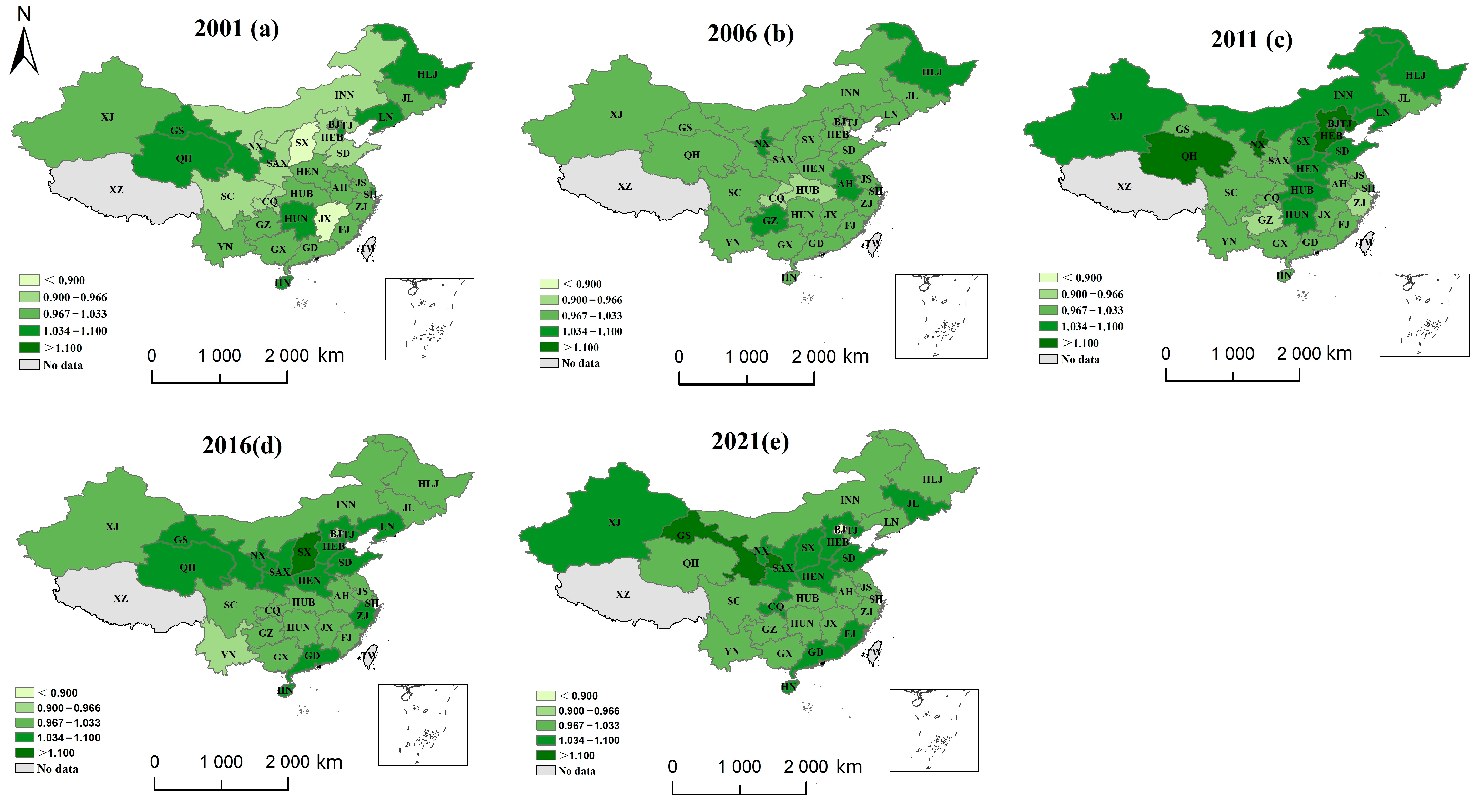
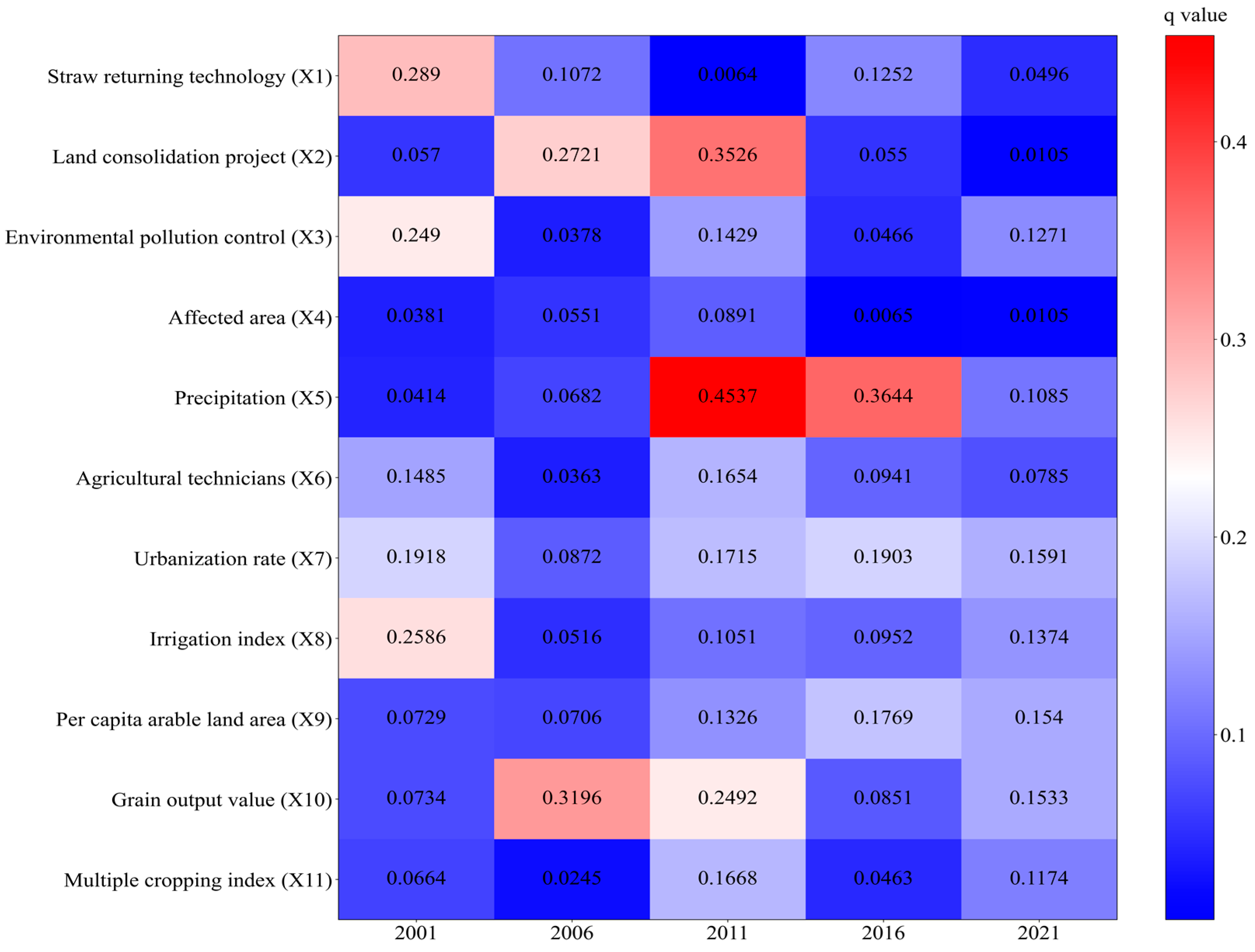


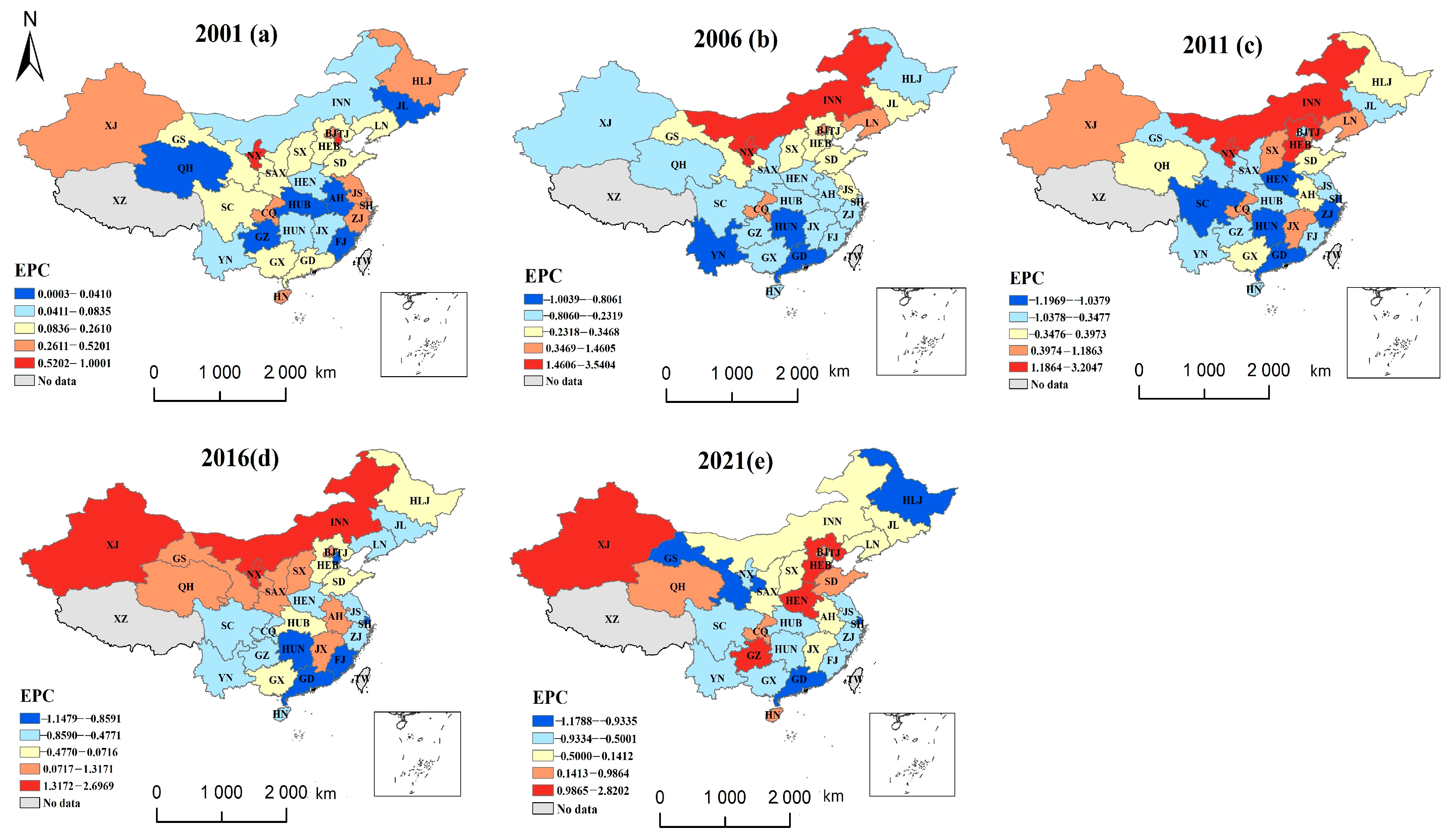
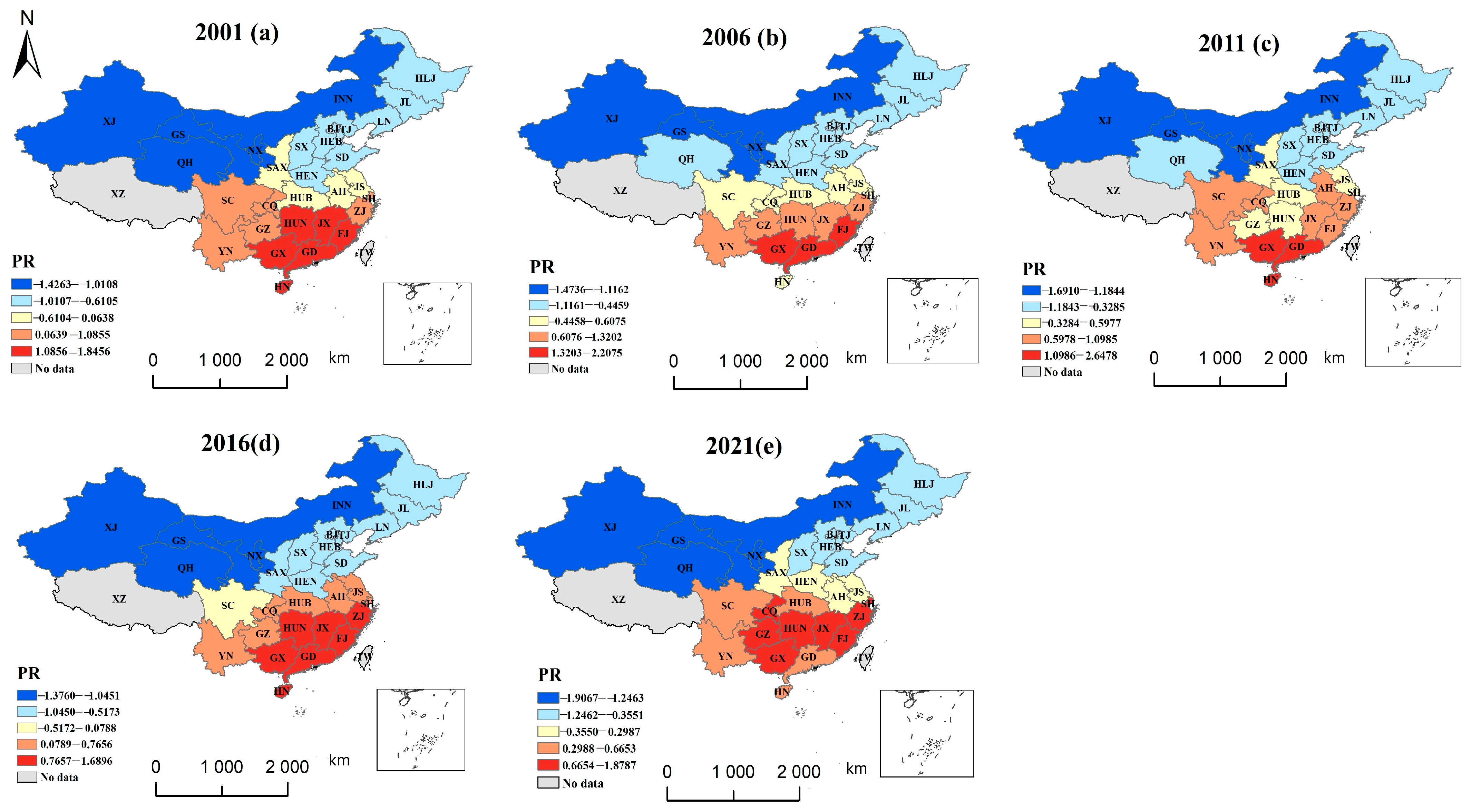
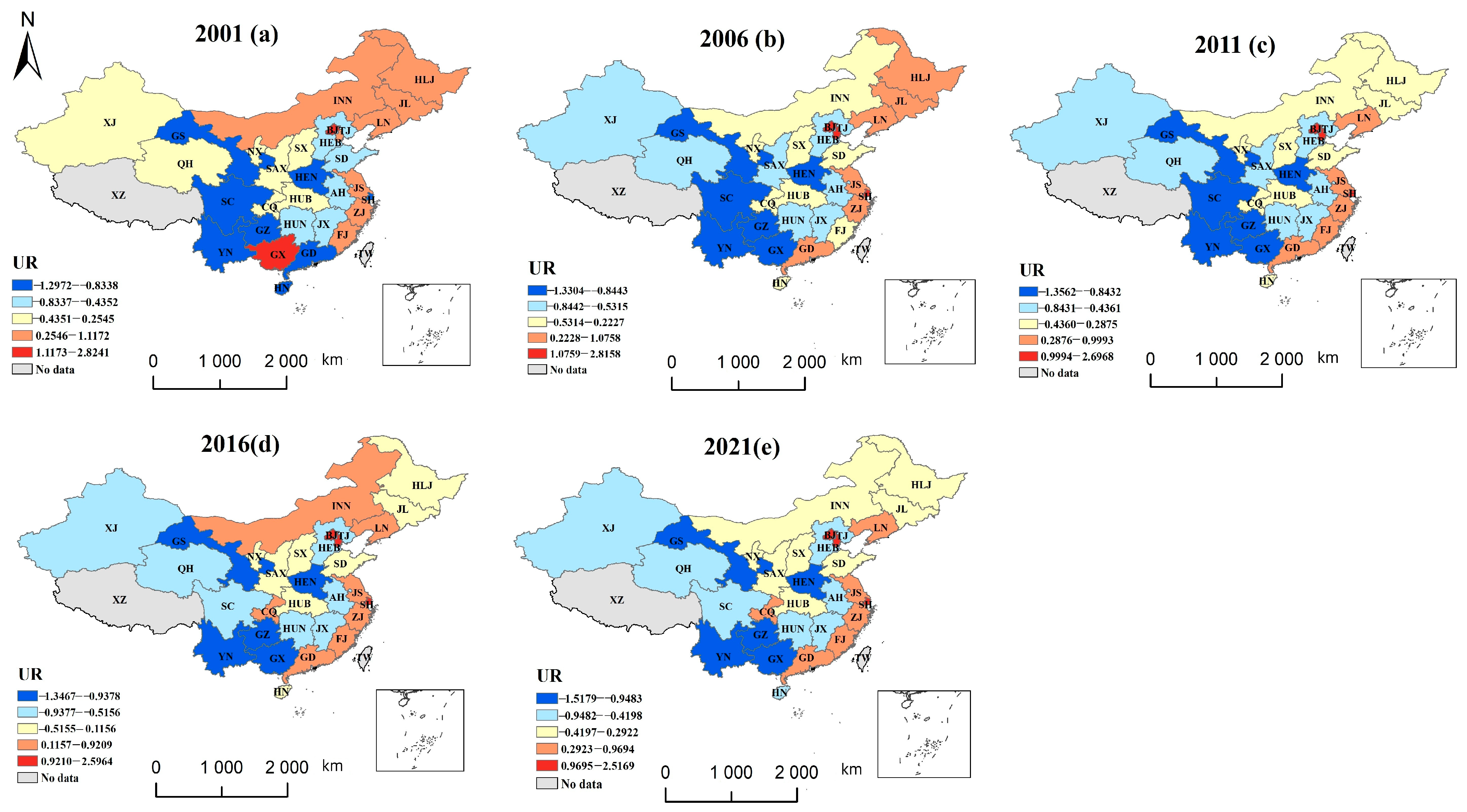

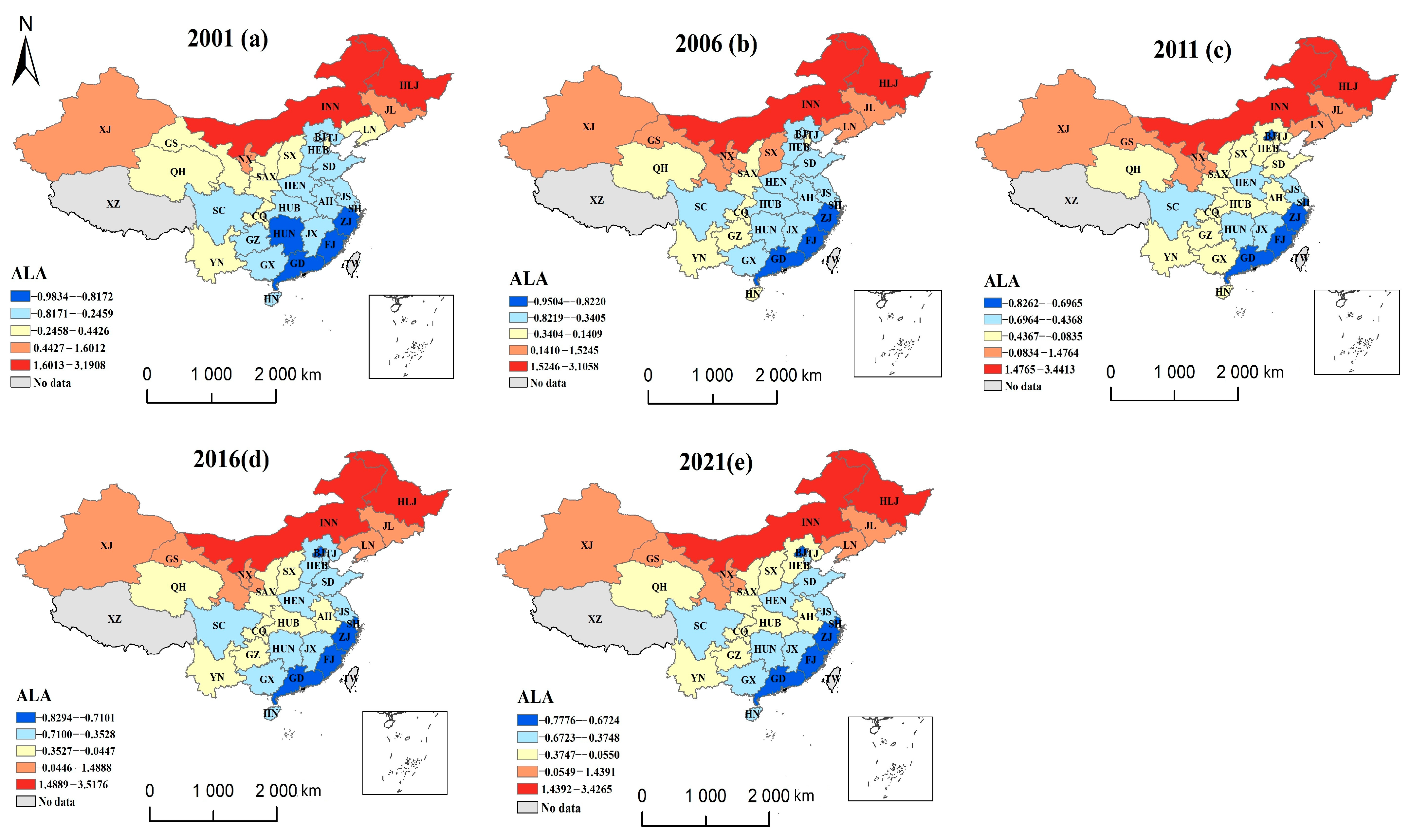
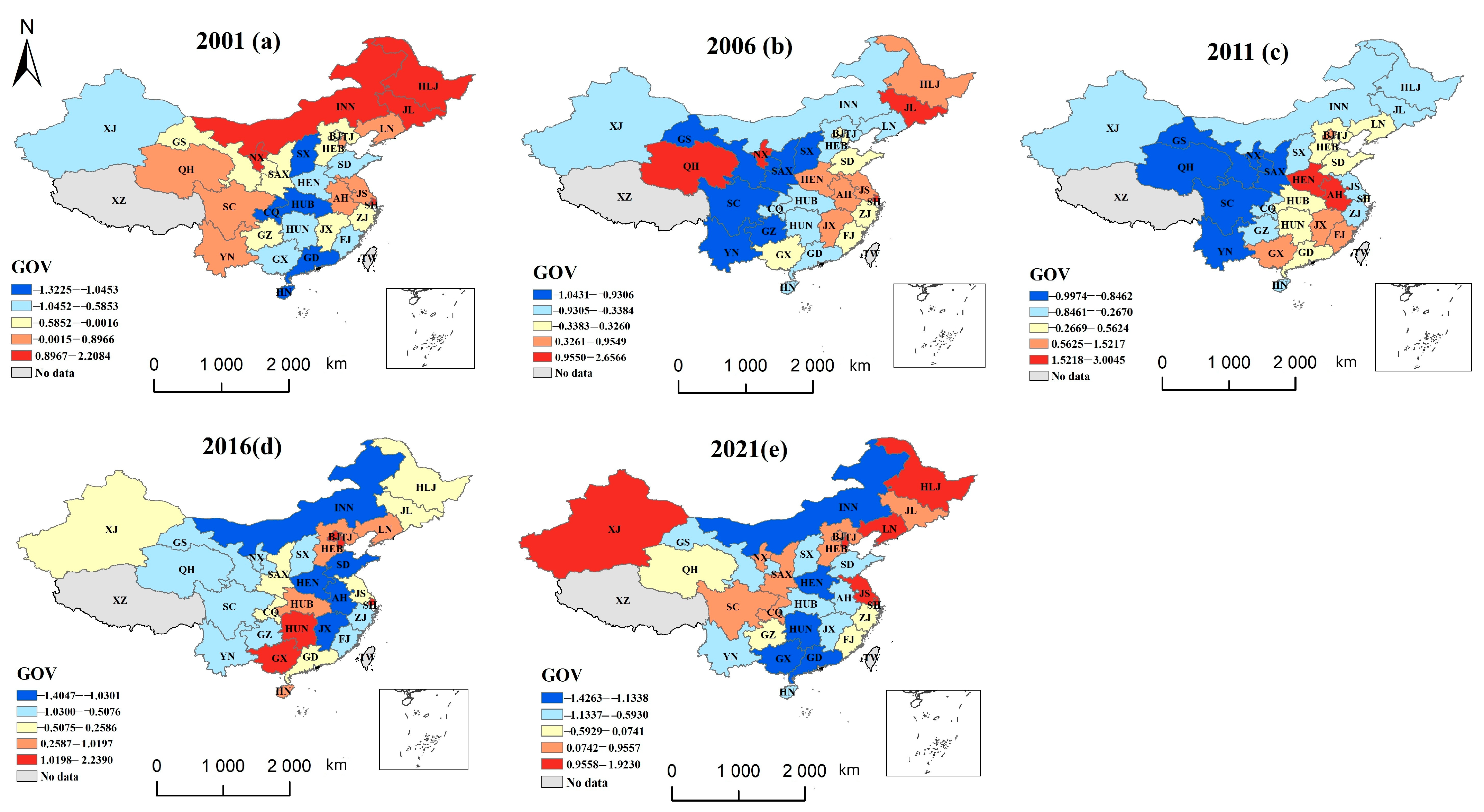
| Criterion Layer | Indicators Description | Unit | Mean | Standard Deviation | Minimum | Maximum |
|---|---|---|---|---|---|---|
| Inputs | Fertilizer consumption per unit of cultivated land area | t/hm2 | 0.447 | 0.223 | 0.087 | 1.216 |
| Pesticide consumption per unit of cultivated land area | t/thousand hm2 | 0.0150 | 0.0125 | 0.0011 | 0.0644 | |
| Proportion of irrigated area | hm2/hm2 | 0.5206 | 0.2487 | 0.1313 | 1.2355 | |
| Amount of primary industry labor force per unit cultivated land area | 10 person/hm2 | 0.1242 | 0.0572 | 0.0181 | 0.3364 | |
| Agricultural machinery power per unit cultivated land area | 10 kw/hm2 | 0.7158 | 0.3935 | 0.1261 | 1.8449 | |
| Desirable outputs | Gross agricultural output value per unit cultivated land area | thousand CNY/hm2 | 36.76 | 32.70 | 35.20 | 206.11 |
| Agricultural carbon sink per unit cultivated land area | t/hm2 | 4.283 | 2.060 | 0.839 | 9.623 | |
| Undesirable output | Agricultural carbon emission per unit cultivated land area | t/hm2 | 3.089 | 3.267 | 0.158 | 13.876 |
| Crop Varieties | mf | Hi | r (%) | Crop Varieties | mf | Hi | r (%) |
|---|---|---|---|---|---|---|---|
| Rice | 0.4144 | 0.45 | 12 | Rapeseed Flower | 0.4500 | 0.25 | 10 |
| Wheat | 0.4853 | 0.40 | 12 | Peanut | 0.4500 | 0.43 | 10 |
| Corn | 0.4709 | 0.40 | 13 | Sugarcane | 0.4500 | 0.50 | 50 |
| Beans | 0.4500 | 0.35 | 13 | Sugar Beet | 0.4072 | 0.70 | 75 |
| Tubers | 0.4226 | 0.65 | 10 | Tobacco | 0.4500 | 0.55 | 85 |
| Cotton | 0.4500 | 0.10 | 8 | Vegetable | 0.4500 | 0.60 | 90 |
| Carbon Sources | Coefficients | Units |
|---|---|---|
| Fertilizers | 0.8956 | kg/kg |
| Pesticides | 4.9341 | kg/kg |
| Agricultural Diesel Fuel | 0.5927 | kg/kg |
| Agricultural Plastic Films | 5.180 | kg/kg |
| Plowing | 312.6 | kg/km2 |
| Irrigation | 266.48 | kg/hm2 |
| Category | Variable Definition | Measurement | Mean | Standard Deviation | Minimum | Maximum |
|---|---|---|---|---|---|---|
| Socio economic factors | Promotion of straw returning technology (X1-SRT) | The promotion scale of mechanized straw returning to the field (thousand hm2) | 1063.54 | 1579.67 | 0.00 | 7239.17 |
| Agricultural technicians (X6-AT) | Number of agricultural technicians (person) | 22,730.96 | 14,751.04 | 2186.00 | 184,461.25 | |
| Urbanization rate (X7-UR) | Urban population/Total population (%) | 0.5238 | 0.1556 | 0.1389 | 0.8960 | |
| Irrigation index (X8-IR) | Effective irrigation area/Cultivated land area (%) | 0.5260 | 0.2459 | 0.1345 | 1.1914 | |
| Per capita grain output value (X10-GOV) | Total output value of agriculture, forestry, animal husbandry and fishing/Number of employees in the primary industry (Yuan/Person) | 29,888.36 | 19,205.52 | 5591.96 | 95,751.10 | |
| Natural factors | Affected area (X4-AF) | Affected area/total planting area of crops (%) | 0.2181 | 0.1549 | 0.0000 | 0.9359 |
| Precipitation (X5-PR) | Annual average precipitation (m) | 0.0029 | 0.0015 | 0.0006 | 0.0064 | |
| Cultivated land resource endowment | Per capita arable land area (X9-ALA) | Cultivated land area/Total rural population (hm2/Person) | 25.0142 | 23.5857 | 3.3039 | 160.4048 |
| Multiple cropping index (X11-MC) | Crop planting area/Cultivated land area (%) | 1.2656 | 0.3916 | 0.5659 | 2.3567 | |
| Institutional factors | Land consolidation project (X2-LCP) | Amount of land consolidation project | 324.82 | 620.30 | 0.00 | 3877.00 |
| Investment in environmental pollution control (X3-EPC) | Investment in environmental pollution control/Gross domestic product (%) | 0.0136 | 0.0078 | 0.0003 | 0.0462 |
| Region | Province | 2001 | 2006 | 2011 | 2016 | 2021 |
|---|---|---|---|---|---|---|
| Northeast | Heilongjiang | 1.0455 | 1.0423 | 1.0365 | 0.9735 | 1.0000 |
| Jili | 0.9846 | 1.0000 | 1.0287 | 1.0000 | 1.0347 | |
| Liaoning | 1.0481 | 1.0049 | 1.0847 | 1.0476 | 1.0202 | |
| East | Beijing | 1.0001 | 1.0175 | 1.0677 | 0.9495 | 0.8989 |
| Tianjin | 1.0442 | 0.9242 | 1.0416 | 1.0552 | 1.0210 | |
| Hebei | 0.9347 | 1.0064 | 1.1054 | 1.0945 | 1.0537 | |
| Shanghai | 1.0481 | 1.0418 | 1.0570 | 0.9721 | 1.0000 | |
| Jiangsu | 1.0198 | 0.9983 | 0.9901 | 1.0303 | 1.0310 | |
| Zhejiang | 0.9960 | 0.9815 | 0.9616 | 1.0659 | 1.0000 | |
| Fujian | 1.0066 | 0.9833 | 1.0291 | 1.0107 | 1.0417 | |
| Shandong | 0.9590 | 0.9937 | 1.0338 | 1.0781 | 1.0360 | |
| Guangdong | 0.9739 | 0.9918 | 1.0178 | 1.0340 | 1.0440 | |
| Hainan | 1.0336 | 1.0129 | 1.0271 | 1.0483 | 1.0611 | |
| Central | Shanxi | 0.8674 | 1.0187 | 1.0541 | 1.1307 | 1.0601 |
| Anhui | 0.9746 | 1.0351 | 1.0203 | 0.9780 | 1.0147 | |
| Jiangxi | 0.8932 | 0.9698 | 0.9692 | 1.0146 | 1.0306 | |
| Henan | 0.9704 | 1.0260 | 1.0381 | 1.0494 | 1.0385 | |
| Hubei | 0.9761 | 0.9626 | 1.0330 | 1.0134 | 1.0301 | |
| Hunan | 1.0568 | 0.9802 | 1.0569 | 1.0062 | 1.0326 | |
| West | Inner Mongolia | 0.9596 | 1.0025 | 1.0621 | 0.9962 | 1.0000 |
| Guangxi | 0.9742 | 0.9933 | 1.0082 | 1.0054 | 1.0007 | |
| Chongqing | 0.9418 | 0.9210 | 0.9959 | 0.9888 | 1.0369 | |
| Sichuan | 0.9374 | 0.9668 | 1.0029 | 1.0160 | 1.0159 | |
| Guizhou | 1.0268 | 1.0740 | 0.9393 | 0.9737 | 0.9724 | |
| Yunnan | 1.0033 | 0.9995 | 1.0254 | 0.9559 | 1.0120 | |
| Shaanxi | 0.8674 | 1.0187 | 1.0541 | 1.1307 | 1.0601 | |
| Ganxu | 1.0350 | 0.9664 | 1.0247 | 1.0663 | 1.1101 | |
| Qinghai | 1.0484 | 0.9952 | 1.1250 | 1.0551 | 1.0205 | |
| Ningxia | 0.9077 | 1.0545 | 1.1036 | 1.07301 | 1.0759 | |
| Xinjiang | 0.9752 | 0.9942 | 1.0575 | 1.0176 | 1.0783 |
| Northeast | East | Central | West | National | |
|---|---|---|---|---|---|
| LCUE | 1.0089 | 1.0175 | 1.0134 | 1.0139 | 1.0145 |
| EC | 1.0005 | 1.0041 | 1.0078 | 1.0029 | 1.0042 |
| TC | 1.0091 | 1.0168 | 1.0162 | 1.0156 | 1.0155 |
| Change rate of LCUE | −0.0055 | 0.0030 | −0.0011 | −0.0006 | — |
| Change rate of EC | −0.0037 | −0.0001 | 0.0036 | −0.0013 | — |
| Change rate of TC | −0.0063 | 0.0013 | 0.0007 | 0.0001 | — |
| LCUE | EC | TC | |
|---|---|---|---|
| Northeast | −0.0004 | 0.0000 | −0.0004 |
| East | 0.0008 | 0.0020 | −0.0016 |
| Central | 0.0037 | 0.0008 | 0.0027 |
| West | 0.0028 | −0.0009 | 0.0037 |
| 1—Beijing (BJ) | 7—Jilin (JL) | 13—Fujian (FJ) | 19—Guangdong (GD) | 25—Yunnan (YN) |
| 2—Tianjin (TJ) | 8—Heilongjiang (HLJ) | 14—Jiangxi (JX) | 20—Guangxi (GX) | 26—Shaanxi (SC) |
| 3—Hebei (HB) | 9—Shanghai (SH) | 15—Shandong (SD) | 21—Hainan (HN) | 27—Gansu (GS) |
| 4—Shanxi (SX) | 10—Jiangsu (JS) | 16—Henan (HN) | 22—Chongqing (CQ) | 28—Qinghai (QH) |
| 5—Inner Mongolia (INN) | 11—Zhejiang (ZJ) | 17—Hubei (HB) | 23—Sichuan (SC) | 29—Ningxia (NX) |
| 6—Liaoning (LN) | 12—Anhui (AH) | 18—Hunan (HN) | 24—Guizhou (GZ) | 30—Xinjiang (XJ) |
| Driving Factors | 2001 | 2006 | 2011 | 2016 | 2021 | |||||
|---|---|---|---|---|---|---|---|---|---|---|
| q | p | q | p | q | p | q | p | q | p | |
| X1 (SRT) | 0.2890 | 0.000 | 0.1072 | 0.0000 | 0.0064 | 0.8886 | 0.1252 | 0.0025 | 0.0496 | 0.2848 |
| X2 (LCP) | 0.0570 | 0.0717 | 0.2721 | 0.0000 | 0.3526 | 0.0000 | 0.0550 | 0.1402 | 0.0105 | 0.8836 |
| X3 (EPC) | 0.2490 | 0.0000 | 0.0378 | 0.3535 | 0.1429 | 0.0000 | 0.0466 | 0.1861 | 0.1271 | 0.0000 |
| X4 (AF) | 0.0381 | 0.1602 | 0.0551 | 0.2266 | 0.0891 | 0.0038 | 0.0065 | 0.8833 | 0.0105 | 0.8659 |
| X5 (PR) | 0.0414 | 0.0951 | 0.0682 | 0.1074 | 0.4537 | 0.0000 | 0.3644 | 0.0000 | 0.1085 | 0.0023 |
| X6 (AT) | 0.1485 | 0.0000 | 0.0363 | 0.4287 | 0.1654 | 0.0000 | 0.0941 | 0.0064 | 0.0785 | 0.0376 |
| X7 (UR) | 0.1918 | 0.0000 | 0.0872 | 0.0129 | 0.1715 | 0.0000 | 0.1903 | 0.0000 | 0.1591 | 0.0000 |
| X8 (IR) | 0.2586 | 0.0000 | 0.0516 | 0.2138 | 0.1051 | 0.0116 | 0.0952 | 0.0189 | 0.1374 | 0.0028 |
| X9 (ALA) | 0.0729 | 0.0289 | 0.0706 | 0.0615 | 0.1326 | 0.0000 | 0.1769 | 0.0000 | 0.1540 | 0.0000 |
| X10 (GOV) | 0.0734 | 0.0115 | 0.3196 | 0.0000 | 0.2492 | 0.0000 | 0.0851 | 0.0243 | 0.1533 | 0.0000 |
| X11(MC) | 0.0664 | 0.0408 | 0.0245 | 0.5603 | 0.1668 | 0.0000 | 0.0463 | 0.1547 | 0.1174 | 0.0000 |
Disclaimer/Publisher’s Note: The statements, opinions and data contained in all publications are solely those of the individual author(s) and contributor(s) and not of MDPI and/or the editor(s). MDPI and/or the editor(s) disclaim responsibility for any injury to people or property resulting from any ideas, methods, instructions or products referred to in the content. |
© 2024 by the authors. Licensee MDPI, Basel, Switzerland. This article is an open access article distributed under the terms and conditions of the Creative Commons Attribution (CC BY) license (https://creativecommons.org/licenses/by/4.0/).
Share and Cite
Tian, Y.; Shi, X. Analysis of Dynamic Evolution and Driving Factors of Low-Carbon Utilization Efficiency of Cultivated Land in China. Agriculture 2024, 14, 526. https://doi.org/10.3390/agriculture14040526
Tian Y, Shi X. Analysis of Dynamic Evolution and Driving Factors of Low-Carbon Utilization Efficiency of Cultivated Land in China. Agriculture. 2024; 14(4):526. https://doi.org/10.3390/agriculture14040526
Chicago/Turabian StyleTian, Yuan, and Xiuyi Shi. 2024. "Analysis of Dynamic Evolution and Driving Factors of Low-Carbon Utilization Efficiency of Cultivated Land in China" Agriculture 14, no. 4: 526. https://doi.org/10.3390/agriculture14040526





